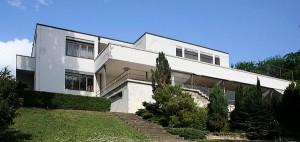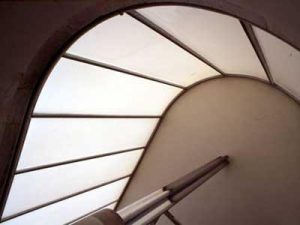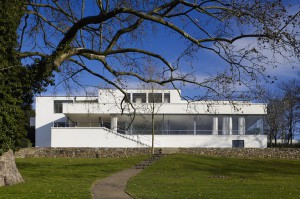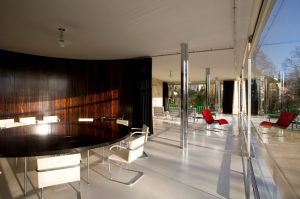The Villa Tugendhat: An architectural gem in Brno
By Tracy A. Burns
An architectural wonder
Listed as a World Cultural and National Heritage UNESCO site since 2001, Brno’s Villa Tugendhat is an architectural wonder due to its structure, layout, furnishing, setting and technical equipment. Its use of rare and exotic materials also makes this functionalist home designed by architect Ludwig Mies van der Rohe unique. This steel load-bearing structure of reinforced concrete is noted for its openness. Its unique furnishings include chairs designed by the architect specifically for the house and an onyx wall. Located in the Brno residential quarter of Černá Pole at 45 Černopolní Street, the villa boasts all of its original furniture, though most are replicas. Brno’s Municipal Museum has been taking care of the three-storey building with a flat roof since 2002. It opened to the public again in March of 2012 after a two-year renovation.
The villa’s history until the 1960s
 The villa has had a colorful history. Its architect, the world-renowned Mies van der Rohe, was a leading contributor to the avant-garde when he designed the house for German-speaking Jews Fritz and Greta Tugendhat from 1928 to 1930. The co-owners of a wool factory moved in with their three children in December of 1930, but they only called the villa home for eight years. In 1938 the Tugendhats emigrated, first to Switzerland and later to Venezuela. (Mies van der Rohe also fled, making his way to the USA, where he died in 1969.) In 1939 the innovative structure was confiscated by the German State Security Police, and its windows were shattered during several World War II bombardments. When the Soviets came in during 1945, it was plundered and used as stables. Horses galloped through the winter garden. After becoming the property of the state that same year, the place hosted a dance school for five years.
The villa has had a colorful history. Its architect, the world-renowned Mies van der Rohe, was a leading contributor to the avant-garde when he designed the house for German-speaking Jews Fritz and Greta Tugendhat from 1928 to 1930. The co-owners of a wool factory moved in with their three children in December of 1930, but they only called the villa home for eight years. In 1938 the Tugendhats emigrated, first to Switzerland and later to Venezuela. (Mies van der Rohe also fled, making his way to the USA, where he died in 1969.) In 1939 the innovative structure was confiscated by the German State Security Police, and its windows were shattered during several World War II bombardments. When the Soviets came in during 1945, it was plundered and used as stables. Horses galloped through the winter garden. After becoming the property of the state that same year, the place hosted a dance school for five years.
From the 1960s to the present
During the 1960s the villa was the site of a rehabilitation center for a teaching hospital. In the late 1960s, Greta came to visit several times and then died in 1970. (Fritz had passed away in 1958.)The city of Brno took over in 1980, and during the 1980s the former Tugendhat residence underwent three years of reconstruction. From 1985 to 1993, visiting dignitaries stayed there. The family tried unsuccessfully to reclaim the property after the 1989 Velvet Revolution. The villa became historically significant when Czech Prime Minister Václav Klaus and Slovak Prime Minister Vladimír Mečiar gathered at its dining room table to sign the document officially splitting Czechoslovakia into two separate countries. The house first opened to the public in July of 1994 and was listed as a national cultural monument the following year. In 2001 it gained recognition from UNESCO. Now, after two years of reconstruction costing 150 million Czech crowns, the villa is open again.
Entrance hall and hallway on the bedroom floor
 One needs to go no further than the entrance hall to discover what makes the villa captivating. The entrance is located behind an opaque, curved, milk glass wall that is the only source of sunlight in this space. The floor is covered with exquisite Italian travertine, and the doors are as high as the room itself, a feature in other spaces as well. Beyond the third-floor entrance hall are the bedrooms. To go to the area where visitors were greeted, it is necessary to take the spiraling staircase down one level. The hall on the way to the bedrooms is lit by a curved wall of opaque etched glass. On the external side, it is glossy, while on the internal side there is a matte surface.
One needs to go no further than the entrance hall to discover what makes the villa captivating. The entrance is located behind an opaque, curved, milk glass wall that is the only source of sunlight in this space. The floor is covered with exquisite Italian travertine, and the doors are as high as the room itself, a feature in other spaces as well. Beyond the third-floor entrance hall are the bedrooms. To go to the area where visitors were greeted, it is necessary to take the spiraling staircase down one level. The hall on the way to the bedrooms is lit by a curved wall of opaque etched glass. On the external side, it is glossy, while on the internal side there is a matte surface.
Fritz’s and Greta’s bedrooms
In both Fritz’s and Greta’s bedrooms, there are authentic built-in closets covering one wall. They are made of veneered palisander. Greta’s room includes red Brno chairs specifically designed for the house by Mies van der Rohe. The Brno chair has a leather seat and back supported by a one-piece bent steel frame. Brno chairs can also be found in the dining room, reception area, and at the bridge table in the library one floor below. Greta’s room also includes a tubular steel round table and is rounded off by a white, sheepskin rug. Silk curtains make an appearance and can be found throughout the house.
Hanna’s room and the nanny’s room
Both the room for the eldest daughter, Hanna, and the nanny’s room boast Zebrano veneered furniture. There is also a blue and gray upholstered Tugendhat chair in the nanny’s room. The Tugendhat chair, also designed by Mies van der Rohe, has a leather-covered upholstered seat and back supported by leather straps across a steel frame with legs. A creamy peach-colored Tugendhat chair lightens up the library, and three more of these chairs grace the living room.
The upper terrace and garden
 The upper terrace and garden are accessed by the bedrooms that look out into the garden via a glass wall. Consisting of a pergano and curved bench with railings, the upper terrace affords a magnificent view of the Brno skyline as the Cathedral of Saints Peter and Paul, some churches, and Špilberk Castle are visible. Because the bedrooms overlook the terrace and garden, they become connected to the setting. A staircase of Italian travertine leads from the terrace to the steep garden facing southwest. The garden emphasizes empty space as it is dominated by a grassy field. Garden paths and various trees – maple, plane, and Sophora as well as a weeping willow – are on the grounds, too. An herb garden is located on the northwest side of the villa.
The upper terrace and garden are accessed by the bedrooms that look out into the garden via a glass wall. Consisting of a pergano and curved bench with railings, the upper terrace affords a magnificent view of the Brno skyline as the Cathedral of Saints Peter and Paul, some churches, and Špilberk Castle are visible. Because the bedrooms overlook the terrace and garden, they become connected to the setting. A staircase of Italian travertine leads from the terrace to the steep garden facing southwest. The garden emphasizes empty space as it is dominated by a grassy field. Garden paths and various trees – maple, plane, and Sophora as well as a weeping willow – are on the grounds, too. An herb garden is located on the northwest side of the villa.
The three sections of the second floor
The second floor can be divided into three sections. The first is the main living room with a winter garden, reception room, music corner, study and library, seating area, dining room, and services. The second section is the kitchen area, and the third is made up of the servants’ part. The main living room areas are divided by a honey and cream-colored onyx wall, a Macassar ebony veneered partition wall that changes color to orange or dark red in some sections, and steel, load-bearing columns.
The living room areas
 The reception area is behind the entrance and is dominated by white furniture and an opaque glazed wall which it is possible to illuminate, making for an intimate setting. There is also a music area with a piano, a study, and a library, where there is a built-in Macassar ebony veneered bookcase along with a sofa and bridge table as well as a hidden space. In front of the onyx wall is a seating area. The chaise lounge provides a cheerful element with its ruby red color. Green Barcelona chairs, which, like the Brno chair, have a leather seat and back on a stainless steel frame, dot the space along with Tugendhat chairs. (Mies van der Rohe designed the Barcelona chair for the German Pavilion of the 1929 International Exposition, held in Barcelona.)
The reception area is behind the entrance and is dominated by white furniture and an opaque glazed wall which it is possible to illuminate, making for an intimate setting. There is also a music area with a piano, a study, and a library, where there is a built-in Macassar ebony veneered bookcase along with a sofa and bridge table as well as a hidden space. In front of the onyx wall is a seating area. The chaise lounge provides a cheerful element with its ruby red color. Green Barcelona chairs, which, like the Brno chair, have a leather seat and back on a stainless steel frame, dot the space along with Tugendhat chairs. (Mies van der Rohe designed the Barcelona chair for the German Pavilion of the 1929 International Exposition, held in Barcelona.)
The dining room, windows, winter garden, and kitchen
The partition wall that is 80 percent original separates the dining room with a black polished pear wood table from the living area. The table can seat 24 and can be transformed into three sizes. White Brno chairs also grace the dining room. The windows in the main living area take up one entire wall and can be moved up and down electronically. The windows connect the living room and garden, practically making the living room part of the garden, thus giving a sense of openness. The winter garden near the library includes blooming plants and a pool for aquatic foliage. There is a food lift, and the walls of the large kitchen are covered from the floor to the ceiling with a perfect alignment of white earthenware tiles. Shelves can be pulled out of the wall cabinet to make counters.
The technical equipment
The technical equipment is by no means limited to the ability to electronically retract the windows. There is a ventilation cooling system and hot air heating system as well. The heating units along the glazed wall in the reception area make sure that the glass does not steam up. Water is circulated by a radial ventilator with an electric drive. A technical ventilation system in one room regulates the temperature of the social spaces. Arrows are connected by iron ropes and operate a sliding door. The entire ventilation system from 1942 still functions. Below the second floor are areas for technical rooms, a laundry room, and a dark room, for example. On the technical tour visitors also see the heating room with boilers and the former washing machine that operated on steam. The storage room for fur coats has all its original tiles. Now there is an exhibition about the house and a gift shop in that space, too.
The latest renovation
During the second extensive restoration, the technical features underwent reconstruction, including the electronically powered windows and the air technology. The garden was also renovated, and a pool for plants was added to the winter garden. The objective of the renovation was to give the villa as much of an authentic look as possible. Some original furniture was retrieved as well. A bathtub turned up in a nearby house while the Macassar ebony curved wall was discovered in the dining area of Brno’s law school. The villa reopened on March 6, 2012, and there are two tours to choose from – the standard tour, which takes an hour, or the technical tour, which is the same as the standard tour plus an extra half hour to tour the technical rooms. Most tours are given in Czech, but some are in English. It is necessary to book a tour at least a month in advance.




